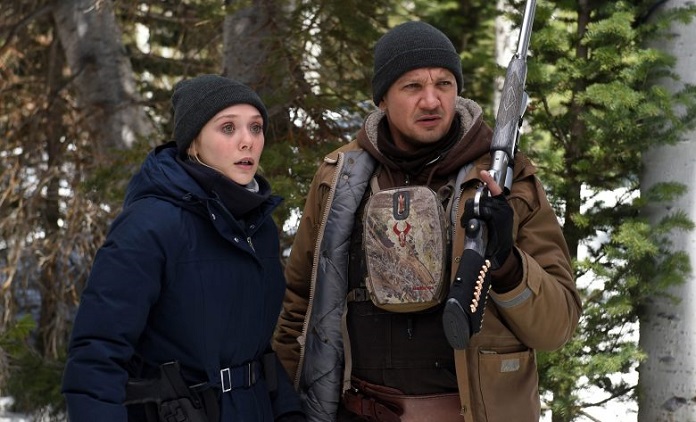
Wind River
Studio: The Weinstein Company
Directed by Taylor Sheridan
Aug 03, 2017
Web Exclusive
![]()
Taylor Sheridan has earned a rare distinction in modern filmmaking: that of the auteur screenwriter. Although his first and second films were shot by different directors with strong personal styles of their own – Denis Villeneuve in the case of Sicario, David Mackenzie in the case of Hell or High Water – both share subject matter and concerns rooted in Sheridan’s scripts. Both offer bleak, uncompromising visions of the modern rural America. Both focus on protagonists fighting the brutal, uncaring systems generated by governments and financial institutions. Both explore sudden, striking violence and the people who commit it. Wind River is a further exploration of these themes, focusing on a rookie FBI agent and a veteran tracker who team up to solve the murder of a young woman on a Wyoming Indian reservation. It’s easy to see why Wind River was the script Sheridan chose for his directorial debut. It’s more intimate and scaled down than Sicario or Hell or High Water, while remaining comfortably in his wheelhouse of grim police procedurals set in rarely explored corners of the American West. Unfortunately, Wind River fails to clear the incredibly high bar set by those previous films.
The chief problem is that the script is considerably weaker than his earlier efforts. Sicario tackled the futility of a single cop attempting to honestly prosecute the war on drugs. Hell or High Water explores the resentment and violence bred by the death spiral of white rural America. The ostensible social issue concering Wind River is the disproportionate rate of domestic violence and murder faced by Native women living on reservations, as helpfully explained by onscreen text at the end of the film. This noble intention feels immediately undercut by Sheridan’s choice of protagonist. Corey Lambert, played with trademark blankness by Jeremy Renner, is a hunter and tracker working for the US Fish and Wildlife Service living on the reservation following his divorce from his Native wife. Using a white character as the insert character for a story about Native Americans is tiresome, but not necessarily a dealbreaker. More questionable is the film’s decision to make Lambert the embodiment of every hoary old Indian trope in the book: he’s a man of few words, possesses almost preternatural hunting and tracking powers, and is told by actual Natives that he knows their land better than anyone else. By the time the film gets around to having him lecture a handcuffed young Native about his poor life choices, it moves beyond the realm of ill-conceived to flat out insulting.
A more natural protagonist would have been Jane Banner, played by Elizabeth Olsen. Although she’s almost too well cast as a neophyte, fish-out-of-water FBI agent, Olsen brings a spark of intelligence and compassion to Banner that makes her feel like an embryonic version of Kate Macer, Sheridan’s other noble female FBI agent portrayed by Emily Blunt in Sicario. Although she has her own small character arc, Banner’s chief function is to have things explained to her by Lambert and be generally well-meaning but ineffectual. But where Sicario pointedly used Macer’s ineffectiveness to demonstrate the futility of the war on drugs, Banner is mostly exists to drive home how competent and badass Lambert is by comparison. Even the natural connection between Banner as a woman to the murdered girl is downplayed in favor of a connection between the victim and Lambert that ends up taking the story down an all-too conventional path.
Although Sheridan saddled himself with his weakest material, he has picked up a few tricks from his earlier collaborators. Wind River features a grueling standoff/shoot-out sequence that is easily on par with the stellar Bridge of the Americas sequence in Sicario and generally does an excellent job of making the Wyoming wilderness feel like a gorgeous, frozen hellscape. Equally gorgeous is the haunting choral score by Nick Cave and Warren Ellis, although that’s to be expected given their track record. It’s difficult to call the film a complete failure given both its general effectiveness as a procedural and its attempts to shed light on social issue rarely portrayed on film. Enough worthwhile elements are present to make the shaky execution seem all the more disappointing.
Author rating: 4/10
Average reader rating: 8/10
Current Issue

Issue #72
Apr 19, 2024 Issue #72 - The ‘90s Issue with The Cardigans and Thurston Moore
Most Recent
- Bat For Lashes Shares a Cover of Baauer’s “Home” From Her New Album (News) — Bat For Lashes, Baauer
- Premiere: Veronica Lewis Shares New Single “Disconnected” (News) — Veronica Lewis
- The Decemberists Share New Song “All I Want Is You” (News) — The Decemberists
- Ella McRobb Releases New Single “Slow Motion Heartbreak” (News) — Ella McRobb
- Light Verse (Review) — Iron & Wine

Comments
Submit your comment
August 25th 2017
8:44pm
This is one of the worst movies I’ve ever seen. Extreme unnecessary violence. Many in the audience (including us) walked out. Out of place in our violent society.